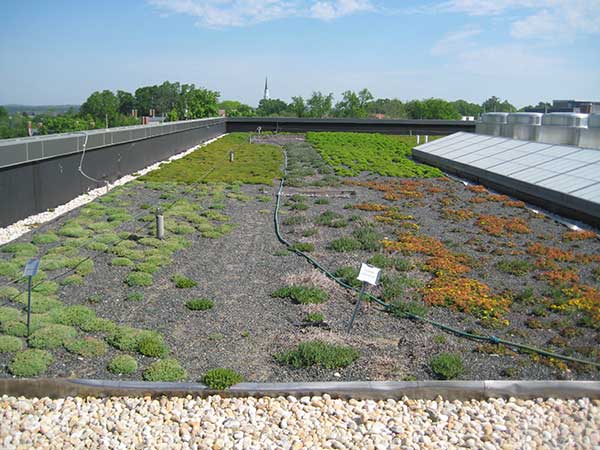Green Roofs
Green roofs, or vegetated roof systems, consist of membranes, soils, and plantings that are installed on top of buildings. There are several functional layers of green roofs. From bottom to top:
- Roof deck
- Insulation
- Waterproofing
- Protection and water storage layer
- Drainage and capillarity layer
- Root permeable filter layer
- Extensive growth media
- Plants and vegetation
The most direct benefits of green roofs are the infiltration and evapotranspiration of stormwater. Green roofs hold and evaporate rainfall in growth media, reducing runoff, and reduce the impact on the existing stormwater management infrastructure. The reduction in runoff volume is the primary benefit that motivates UNC-Chapel Hill to pursue more green roof projects. Additionally, the evapotranspiration that occurs within green roofs removes pollutants from water.
Green roofs also provide an extra layer of insulation for buildings as well as prevent heat loss in cold weather and cool air loss during hot weather. This insulation increases the energy efficiency of the building and therefore increases energy savings and reduces the building’s carbon footprint.
There are also many qualitative and social benefits of green roofs. As green spaces, green roofs can improve workspace experience, and ultimately productivity for workers and students.
- Installation: 2005
- Irrigation water source: Potable
- Drainage destination: Storm system
- Planted roof area: 2,860 square feet
- Soil media depth: 6+ inches (possibly significantly deeper in some areas)
- Viewing access: Enter Carrington Hall Addition. Take elevator to fourth floor. Exist onto roof by glass door.
This green roof has evolved into a community space.


- Installation: 2007
- Irrigation water source: Potable
- Drainage destination: Cistern that serves toilets in building
- Planted roof area: 11,420 square feet
- Soil media depth: 5.25-6 inches
- Sedum species: Sexangular, Blue Spruce, Diffusum, Spurium Roseum, Coral Reef, Floriferum Weihenstephaner Gold, Spurium Fludagult, Angelina, Lamtschaticum, Spurium John Creech, Sieboldii, Bithynicum, Hens and Chicks
- Delosperma species: Nubigenum Ice Plant, Cooperii Ice Plant
- Viewing access: Enter from lobby and proceed past information booth. Turn left to elevators and take elevator to fourth floor. Door to green roof is straight ahead.
This green roof drains to a cistern, which serves the toilets in the building. This site also features outdoor seating for informal meetings, study space, or lunch during breaks.



- Installation: 2005
- Irrigation water source: Rain water
- Drainage destination: Cistern that serves irrigation
- Planted roof area: 21,920 square feet
- Soil media depth: Varies; ~2.5 feet
- Viewing access: Off Stadium Drive, between Loudermilk Center for Excellence and Chase Dining Hall.
This green roof is also referred to as a rooftop landscape. It is located on top of the Rams Head Parking Deck. The vegetated roof at the Rams Head Plaza has a soil layer that is thick enough to support trees that will eventually grow to heights of 40-60 feet.


- Installation: 2011
- Irrigation water source: Potable
- Drainage destination: Storm system
- Planted roof area: 690 square feet (section one), 3,470 square feet (section two)
- Soil media depth: 3-4 inches
- Viewing access: From entrance to Loudermilk Center for Excellence (or Rams Head Parking Deck side), take elevator to third floor. Exit onto concourse and turn right. At the end of the Loudermilk building (before stadium seating), there is an external staircase that goes to a fourth floor patio area that contains the green roof.
The 690-square-feet section is the smallest green roof on campus!


- Installation: 2011
- Irrigation water source: Potable
- Drainage destination: Storm system
- Planted roof area: 5,120 square feet
- Soil media depth: 4 inches
This roof is not accessible for the public to walk out onto, but is visible from large windows directly across from the elevator, as well as from offices that surround the green roof.
- Installation: 2014
- Irrigation water source: Non-potable (mix of rainwater & reclaimed water)
- Drainage destination: Cistern that feeds irrigation and toilets
- Planted roof area: 7380 square feet
- Viewing access: Green roof can be viewed from Fordham Hall. Take the elevator to the sixth floor. Walk to the northeast corner of the building, which faces the Genome Sciences Building. View the green roof from the windows or balconies.
- Installation: 2014
- Irrigation water source: Non-potable (mix of rainwater & reclaimed water)
- Drainage destination: Cistern that feeds irrigation and toilets
- Planted roof area: 3220 square feet
- Viewing access: Go to the second floor outdoor patio area behind the University Employee Occupational Health Clinic (part of the NC Area Health Education Center). Also visible from the upper floors of Fordham Hall and the Genome Sciences Building.

- Installation: 2010
- Drainage destination: Storm system
- Planted roof area: 830 square feet
- Soil media depth: 6 inches
- Viewing access: Not visible to the public.
- Plant species: Sedum reflexum (Blue Spruce), Sedum rupestre Angelina

